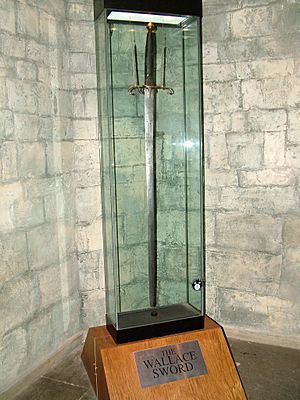Wallace Sword facts for kids
The Wallace Sword is a very old two-handed sword. People believe it belonged to William Wallace (1270–1305). He was a Scottish knight who led a fight for freedom against the English army. This happened during the First War of Scottish Independence.
Many stories say William Wallace used this sword in important battles. These include the Battle of Stirling Bridge in 1297 and the Battle of Falkirk (1298).
The sword is about 163 centimeters (5 feet 4 inches) long. The blade itself is about 132 centimeters (4 feet 4 inches) long. It weighs about 2.7 kilograms (5.95 pounds).
Today, you can see the Wallace Sword at the National Wallace Monument in Stirling, Scotland. It is a famous piece of Scottish history.
Quick facts for kids Wallace Sword |
|
|---|---|

The Wallace Sword.
|
|
| Type | two-handed sword |
| Place of origin | Scotland |
| Service history | |
| In service | 13th-century |
| Used by | William Wallace |
| Wars | |
| Specifications | |
| Mass | 5.95 pounds (2.70 kg) |
| Length | 5 feet 4 inches (163 cm) |
Contents
The Sword's Journey Through Time
Early Records of the Wallace Sword
After William Wallace was executed in 1305, some stories say the sword went to John de Menteith. He was the governor of Dumbarton Castle. However, there are no clear records to prove this.
About 200 years later, in 1505, King James IV of Scotland ordered repairs for the sword. Records show that 26 shillings were paid to an armourer. The sword was given a new handle (hilt), a new knob at the end of the handle (pommel), and a new cover (scabbard) and belt. This shows the sword was important even then. It was called the "Wallas sword."
How the Sword Was Examined
For the next 300 years, there are no written records about the sword. Then, in 1825, the sword was sent to the Tower of London for repairs. The Duke of Wellington asked an expert named Samuel Meyrick to look at it.
Meyrick was very good at studying old swords. But he only looked at the parts that had been replaced in the 1500s. Because of this, he thought the sword could not be older than the 1400s. He did not pay enough attention to the blade itself. The blade must have been important for King James IV to have it repaired and called "Wallas sword."
Finding a Home at the Monument
In 1888, a writer named Charles Rogers helped bring the sword to its current home. He wrote to the government and convinced them to move the sword. It was then placed in the Wallace Monument for everyone to see and protect.
Traveling to New York
In 2005, the Wallace Sword left Scotland for the first time in modern history. It traveled to New York City. There, it was shown at Grand Central Terminal during a Scottish festival called Tartan Week.
Recent Events
In March 2023, the sword's display case was damaged. Workers are now checking to see if the sword itself was also harmed.
Is It Really Wallace's Sword?
Looking Closely at the Blade
Experts have looked very closely at the Wallace Sword. They have found some interesting things that make them wonder if it is the exact sword William Wallace used.
For example, the blade does not have a "fuller." A fuller is a long groove often found in sword blades. It makes the blade lighter and stronger. Most swords from Wallace's time had this feature.
What Old Swords Looked Like
Swords from the late 1200s, like the ones Wallace might have used, were usually long and wide. They had parallel edges and a rounded tip. The handle was often long enough for two hands, about 15 centimeters (6 inches). The guard (the part between the blade and the handle) might have been straight or angled downwards. The pommel (the knob at the end of the handle) was often shaped like a Brazil nut or a disk.
Pieces of Different Swords?
Some experts believe the Wallace Sword might be made from parts of different swords put together. One part of the blade, the very bottom piece, looks like it could be from a 13th-century sword. This gives some hope to those who believe it truly belonged to Wallace.
However, other parts, like a flat section near the handle called a "ricasso," are not usually found on medieval swords. This feature became common much later, in the 1500s or 1600s. So, the sword we see today might be a mix of old and newer parts. It's a bit like a famous puzzle where parts are replaced over time.

